What's New
Displaying results 3301 - 3310 of 4052
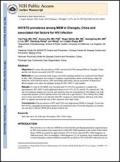
Resource | Publications,
Men who have sex with men (MSM) have been harshly and disproportionately impacted upon by HIV and continue to be a major driver of the HIV/AIDS epidemic in the world. In the United States, MSM accounted for approximately 45% of newly reported HIV/AIDS diagnoses in 2006 and nearly 54% of cumulative AIDS diagnoses.
The prevalences of HIV and STDs were high among MSM in Chengdu. To prevent HIV/STDs, campaigns promoting condom use are needed not only to boost the frequency of condom use, but also to educate MSM about proper condom use.
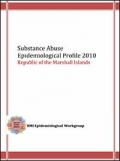
Resource | Publications,
This profile resulted from the collaborative efforts of the various agencies and institutions that comprise RMI Epidemiological Outcomes Workgroup (RMI Epi Workgroup) with coordination by Marshall Islands Epidemiology and Prevention Initiatives Inc. (MIEPI).
In this 2010 National Epi Profile, MIEPI has been able to collect additional substance abuse related data for the SPF SIG Bobrae Project through collaboration with project partners including WUTMI, PPP, and YTYIH. RMI will also continue to improve its RMI Epi Profile to integrate substance abuse treatment, recovery and mental health related data.

Resource | Presentations,
Since the first detection of HIV in Bangladesh in 1989, the rate of infection has not been increased in comparison to our neighbors. Bangladesh still to be low prevalent country in the region with prevalence < 1% among MARP.

Resource | Presentations,
Behavioral sentinel surveillance (BSS) has been conducted by NCHADS to document behavior changes among sentinel groups since 1997. The objectives of the BSS 2010 are:
- To document HIV related risk behaviors among selected sentinel groups
- To track trends in risk behaviors among most at risk groups
- To explore common practices toward the use of VCT, STI clinics and other health services
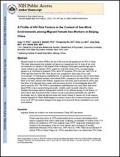
Resource | Publications,
Migrant female sex workers (FSWs) are one of the most at-risk populations for HIV in China. This study demonstrates how multiple risk factors are situated and vary by types of sex work environments in a sample of 348 migrant FSWs in Beijing. Participants reported high rates of clients' refusal to use condoms (76%), unsafe sex with both clients (32%), non-paid regular partners (e.g., boyfriend or husband) (76%), and a STI symptom (79%) last year. Only 22% of FSWs had been tested for HIV. Risk factors were compared by three types of sex work environments.
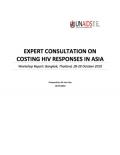
Resource | Publications,
An Expert Consultation on Costing HIV Responses in Asia-Pacific was held from 28 to 29 October 2010 for expert developers and users to assess the usefulness of various costing tools for different purposes, as well as their comparability and complementarities. The meeting outcomes were intended to support the HIV National Strategic Planning process and Global Fund (and other) proposal development at a time when resources are expected to decline, so that countries must prioritize and implement the most cost-effective programmes.
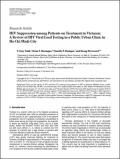
Resource | Publications,
Vietnam is a country with one of the highest prevalences of HIV in Southeast Asia. With an estimated prevalence of 293,000 people in 2007 (approximately 0.5% of the general population), the HIV epidemic is primarily concentrated in urban areas among key high-risk populations, the majority of which are injection drug users (IDU), and to a lesser extent, female sex workers (FSWs) and men who have sex with men (MSM). Efforts to confront the HIV epidemic in Vietnam face a high burden of patients with comorbid substance abuse and limited resources. International efforts to scale up antiretroviral therapy (ART) have greatly improved funding for treatment in Vietnam, allowing for approximately 14,969 people to receive ART as of 2007.
The goals of this study were to document ART efforts in a resource-limited setting with high prevalence of IDUs, to identify high-risk groups for failure who may benefit from more frequent monitoring or other interventions and to assess the potential for delayed diagnosis of treatment failure when using targeted testing based on clinical and immunologic criteria.
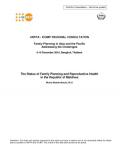
Resource | Publications,
This paper presents the status of family planning (FP) in the context of improving access to reproductive health services in the republic of the Maldives. Methodology adopted while preparing the paper include extensive desk review as well as interaction with key stakeholders-government, donors/development partners and NGOs that the author has undertaken during a visit to Male, the capital city of Maldives.
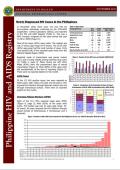
Resource | Fact Sheets,
In November 2010, there were 112 new HIV Ab seropositive individuals confirmed by the STD/AIDS Cooperative Central Laboratory (SACCL) and reported to the HIV and AIDS Registry (Table 1). This was a 40% increase compared to the same period last year (n=80 in 2009) [Figure 1].

Resource | Publications,
This People Living with HIV Stigma Index report is a result of a series of consultations with key stakeholders including membership of three networks of HIV positive people, and the National Partnership comprising of UN joint team on AIDS, the National STD & AIDS Control Programme and the Family Planning Association of Sri Lanka.
Key amongst the many findings of the Sri Lankan Stigma Index Report are the high levels of "internalised stigma" experienced by people who are infected or affected by HIV and the "corresponding decisions" they make in the face of the many structural or invisible societal barriers in Sri Lankan society. Unfair stereotyping of people with HIV is linked to prejudicial attitudes and there is a need to strengthen avenues through which remedies can be sought by those who have been discriminated against.





